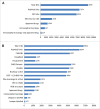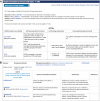The IUPHAR/BPS Guide to PHARMACOLOGY in 2018: updates and expansion to encompass the new guide to IMMUNOPHARMACOLOGY
- PMID: 29149325
- PMCID: PMC5753190
- DOI: 10.1093/nar/gkx1121
The IUPHAR/BPS Guide to PHARMACOLOGY in 2018: updates and expansion to encompass the new guide to IMMUNOPHARMACOLOGY
Abstract
The IUPHAR/BPS Guide to PHARMACOLOGY (GtoPdb, www.guidetopharmacology.org) and its precursor IUPHAR-DB, have captured expert-curated interactions between targets and ligands from selected papers in pharmacology and drug discovery since 2003. This resource continues to be developed in conjunction with the International Union of Basic and Clinical Pharmacology (IUPHAR) and the British Pharmacological Society (BPS). As previously described, our unique model of content selection and quality control is based on 96 target-class subcommittees comprising 512 scientists collaborating with in-house curators. This update describes content expansion, new features and interoperability improvements introduced in the 10 releases since August 2015. Our relationship matrix now describes ∼9000 ligands, ∼15 000 binding constants, ∼6000 papers and ∼1700 human proteins. As an important addition, we also introduce our newly funded project for the Guide to IMMUNOPHARMACOLOGY (GtoImmuPdb, www.guidetoimmunopharmacology.org). This has been 'forked' from the well-established GtoPdb data model and expanded into new types of data related to the immune system and inflammatory processes. This includes new ligands, targets, pathways, cell types and diseases for which we are recruiting new IUPHAR expert committees. Designed as an immunopharmacological gateway, it also has an emphasis on potential therapeutic interventions.
© The Author(s) 2017. Published by Oxford University Press on behalf of Nucleic Acids Research.
Figures








Comment in
-
A new guide to immunopharmacology.Nat Rev Immunol. 2018 Dec;18(12):729. doi: 10.1038/s41577-018-0079-2. Nat Rev Immunol. 2018. PMID: 30327546 No abstract available.
Similar articles
-
The IUPHAR/BPS Guide to PHARMACOLOGY in 2016: towards curated quantitative interactions between 1300 protein targets and 6000 ligands.Nucleic Acids Res. 2016 Jan 4;44(D1):D1054-68. doi: 10.1093/nar/gkv1037. Epub 2015 Oct 12. Nucleic Acids Res. 2016. PMID: 26464438 Free PMC article.
-
The IUPHAR/BPS Guide to PHARMACOLOGY in 2020: extending immunopharmacology content and introducing the IUPHAR/MMV Guide to MALARIA PHARMACOLOGY.Nucleic Acids Res. 2020 Jan 8;48(D1):D1006-D1021. doi: 10.1093/nar/gkz951. Nucleic Acids Res. 2020. PMID: 31691834 Free PMC article.
-
The IUPHAR/BPS Guide to PHARMACOLOGY: an expert-driven knowledgebase of drug targets and their ligands.Nucleic Acids Res. 2014 Jan;42(Database issue):D1098-106. doi: 10.1093/nar/gkt1143. Epub 2013 Nov 14. Nucleic Acids Res. 2014. PMID: 24234439 Free PMC article.
-
The IUPHAR Guide to Immunopharmacology: connecting immunology and pharmacology.Immunology. 2020 May;160(1):10-23. doi: 10.1111/imm.13175. Epub 2020 Mar 2. Immunology. 2020. PMID: 32020584 Free PMC article. Review.
-
Challenges of Connecting Chemistry to Pharmacology: Perspectives from Curating the IUPHAR/BPS Guide to PHARMACOLOGY.ACS Omega. 2018 Jul 31;3(7):8408-8420. doi: 10.1021/acsomega.8b00884. ACS Omega. 2018. PMID: 30087946 Free PMC article. Review.
Cited by
-
The preclinical pharmacokinetics of Tolinapant-A dual cIAP1/XIAP antagonist with in vivo efficacy.Pharmacol Res Perspect. 2024 Dec;12(6):e70030. doi: 10.1002/prp2.70030. Pharmacol Res Perspect. 2024. PMID: 39450695 Free PMC article.
-
Cannabidiol inhibits the skeletal muscle Nav1.4 by blocking its pore and by altering membrane elasticity.J Gen Physiol. 2021 May 3;153(5):e202012701. doi: 10.1085/jgp.202012701. J Gen Physiol. 2021. PMID: 33836525 Free PMC article.
-
Pharmacokinetics and pharmacodynamics of the factor XIa-inhibiting antibody osocimab in healthy male East Asian volunteers: Results from two phase 1 studies.Pharmacol Res Perspect. 2024 Oct;12(5):e70012. doi: 10.1002/prp2.70012. Pharmacol Res Perspect. 2024. PMID: 39308062 Free PMC article. Clinical Trial.
-
Revealing the Activity of Trimeric G-proteins in Live Cells with a Versatile Biosensor Design.Cell. 2020 Aug 6;182(3):770-785.e16. doi: 10.1016/j.cell.2020.06.020. Epub 2020 Jul 6. Cell. 2020. PMID: 32634377 Free PMC article.
-
Nicotine addiction and the influence of life adversity and acute stress on PYY: Prediction of early smoking relapse.Pharmacol Res Perspect. 2024 Oct;12(5):e70016. doi: 10.1002/prp2.70016. Pharmacol Res Perspect. 2024. PMID: 39315578 Free PMC article.
References
-
- Pawson A.J., Sharman J.L., Benson H.E., Faccenda E., Alexander S.P., Buneman O.P., Davenport A.P., McGrath J.C., Peters J.A., Southan C. et al. . The IUPHAR/BPS Guide to PHARMACOLOGY: an expert-driven knowledgebase of drug targets and their ligands. Nucleic Acids Res. 2014; 42:D1098–D1106. - PMC - PubMed
-
- Southan C., Sharman J.L., Benson H.E., Faccenda E., Pawson A.J., Alexander S.P., Buneman O.P., Davenport A.P., McGrath J.C., Peters J.A. et al. . The IUPHAR/BPS Guide to PHARMACOLOGY in 2016: towards curated quantitative interactions between 1300 protein targets and 6000 ligands. Nucleic Acids Res. 2016; 44:D1054–D1068. - PMC - PubMed
Publication types
MeSH terms
Substances
Grants and funding
LinkOut - more resources
Full Text Sources
Other Literature Sources
Medical
Molecular Biology Databases
Research Materials
Miscellaneous

